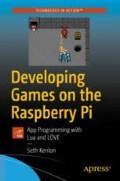Abstract
There are lots of ways to store data. In the Blackjack game, you stored the building blocks for a deck of playing cards in two tables—one for suits and one for values. That’s a good method for small data sets that don’t change from game to game, but it won’t work if, for instance, it was possible for a player to level up and earn the ability to play with Jokers in the deck, because the tables defining the deck is hard-coded into the application.
Access this chapter
Tax calculation will be finalised at checkout
Purchases are for personal use only
Author information
Authors and Affiliations
Rights and permissions
Copyright information
© 2019 Seth Kenlon
About this chapter
Cite this chapter
Kenlon, S. (2019). Database and Libraries. In: Developing Games on the Raspberry Pi. Apress, Berkeley, CA. https://doi.org/10.1007/978-1-4842-4170-7_5
Download citation
DOI: https://doi.org/10.1007/978-1-4842-4170-7_5
Published:
Publisher Name: Apress, Berkeley, CA
Print ISBN: 978-1-4842-4169-1
Online ISBN: 978-1-4842-4170-7
eBook Packages: Professional and Applied ComputingApress Access BooksProfessional and Applied Computing (R0)

